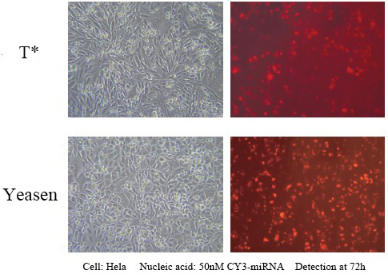Description
Hieff Trans™ in vitro siRNA/miRNA Transfection Reagent is a PEI cationic, amphiphilic transfection reagent developed for the transfection of siRNA into mammalian cells. Suitable for transfection of siRNA and miRNA. This transfection reagent encapsulates siRNA or miRNA to form a cationic complex, which interacts with negatively charged proteoglycans on the cell surface and adsorbs on the cell surface, enters the cell through endocytosis, and forms an inclusion body. The transfection reagent acts as a proton sponge, which can absorb H+ in the lysosome, and the continuous influx of protons causes the complex to swell and rupture, thereby releasing the exogenous siRNA or miRNA into the cytoplasm.
This product can achieve over 90% expression efficiency of 1 nM siRNA in a wide range of cell lines, avoiding off-target effects. Suitable for transfection of a variety of cells, including Hela, MCF-7, HepG2, CHO, and other adherent cells; and difficult to transfect suspension cell lines, such as K562 or THP-1 cells, can achieve 80% silencing efficiency; Including some primary cells, primary human fibroblasts, and primary human hepatocytes, etc., the silencing efficiency of 80% can be achieved.
Feature
- Low toxicity: the transfected cells still maintain good activity.
- Wide adaptability: ordinary cells and primary cells difficult to transfect are fully covered.
Application
- Cell Transfection
Specification
| Physical and chemical Properties | Information |
| Form | Liquid |
| Serum Compatible | Yes |
| Cell Type | Established Cell Lines |
| Sample Type | siRNA/miRNA |
| Transfection Technique | PEI-Based Transfection |
Components
| Components No. | Name | 40806ES01 | 40821ES02 | 40821ES03 |
| 40806 | Hieff Trans™ in vitro siRNA/miRNA Transfection Reagent | 0.1 mL | 0.5 mL | 1 mL |
Storage
The product should be stored at 2-8ºC for one year. Do not freeze!
Figures
- Demonstration of Transfection Effect

Figure 1. The transfection efficiency of Hieff Trans™ in vitro siRNA/miRNA Transfection Reagent was shown above.
(1) Q: What is the difference between DNA transfection and siRNA transfection?
A: 1. Since there are only 20 base pairs, siRNA is much smaller than DNA with thousands or even more than 10,000 base pairs.
2. The transfection reagents and methods used to transfect DNA are not suitable for transfection of siRNA.
3. siRNA transfection has stricter requirements on the cytotoxicity of transfection reagents than DNA transfection.
(2) Q: Does the transfection reagent need to be changed after transfection?
A: For the medium change, two situations can be distinguished:
1. If there is no medium change before transfection, the medium should be changed about 6 hours after transfection to ensure the nutrients needed for cell growth;
2. If there is a change before transfection The medium can be changed as usual when the medium is nutrient deficient.
(3) Q: What is the efficiency of PEI transfection reagent for transfecting siRNA and plasmid?
A: This PEI transfection reagent is specially developed for siRNA, and plasmid transfection is not recommended.
(4) Q: Can the transfection reagent be frozen?
A: Do not freeze, because the transfection reagent is a PEI cationic transfection reagent. Freezing at low temperature will destroy the activity of the PEI transfection reagent. Therefore, it is best to store it at 4 degrees to maintain the best transfection efficiency.
(5) Q: How to improve the transfection efficiency?
A: a: Density of cells at the time of transfection, 30%-50%.
b: Opti-MEM serum-free medium should be used for siRNA and liposome dilution during transfection.
c: The medium can be changed 4-6h after transfection.
[1] Zhang Y, Hu R, Xi B, Nie D, Xu H, Liu A. Mechanisms of Senescence-Related NKG2D Ligands Release and Immune Escape Induced by Chemotherapy in Neuroblastoma Cells. Front Cell Dev Biol. 2022;10:829404. Published 2022 Mar 2. doi:10.3389/fcell.2022.829404(IF:6.684)
[2] Cui B, Wang Y, Jin J, et al. Resveratrol Treats UVB-Induced Photoaging by Anti-MMP Expression, through Anti-Inflammatory, Antioxidant, and Antiapoptotic Properties, and Treats Photoaging by Upregulating VEGF-B Expression. Oxid Med Cell Longev. 2022;2022:6037303. Published 2022 Jan 4. doi:10.1155/2022/6037303(IF:6.543)
[3] Liu Y, Zeng Y, Si HB, Tang L, Xie HQ, Shen B. Exosomes Derived From Human Urine-Derived Stem Cells Overexpressing miR-140-5p Alleviate Knee Osteoarthritis Through Downregulation of VEGFA in a Rat Model. Am J Sports Med. 2022;50(4):1088-1105. doi:10.1177/03635465221073991(IF:6.203)
[4] Zhang ZD, Wen B, Li DJ, et al. AKT serine/threonine kinase 2-mediated phosphorylation of fascin threonine 403 regulates esophageal cancer progression. Int J Biochem Cell Biol. 2022;145:106188. doi:10.1016/j.biocel.2022.106188(IF:5.085)
[5] Tan S, Zhou Y, Zhao H, et al. Comprehensive transcriptome analysis of hypothalamus reveals genes associated with disorders of sex development in pigs. J Steroid Biochem Mol Biol. 2021;210:105875. doi:10.1016/j.jsbmb.2021.105875(IF:4.294)
[6] Niu M, Yi M, Dong B, Luo S, Wu K. Upregulation of STAT1-CCL5 axis is a biomarker of colon cancer and promotes the proliferation of colon cancer cells. Ann Transl Med. 2020;8(15):951. doi:10.21037/atm-20-4428(IF:3.297)
Payment & Security
Your payment information is processed securely. We do not store credit card details nor have access to your credit card information.
Inquiry
You may also like
FAQ
The product is for research purposes only and is not intended for therapeutic or diagnostic use in humans or animals. Products and content are protected by patents, trademarks, and copyrights owned by Yeasen Biotechnology. Trademark symbols indicate the country of origin, not necessarily registration in all regions.
Certain applications may require additional third-party intellectual property rights.
Yeasen is dedicated to ethical science, believing our research should address critical questions while ensuring safety and ethical standards.

